This post may contain affiliate links for which I earn a small commission at no extra cost to you. For more info, check out my Disclosure Policy. Thank you for your support!
If you’re looking for the BEST gluten free pastry recipe then look no further!
This gluten free shortcrust pastry is surprisingly easy and I have a full step-by-step guide and video tutorial just for you.
This blog post has everything you need for the perfect gluten free shortcrust pastry.
We’ll cover everything from how to make it, through to my top tips and my favourite pastry-based recipes.
It’s the perfect gluten free pie crust recipe and one which should absolutely be in your gluten free baking repertoire.
And if you’ve mastered the art of this and want to give my gluten free puff pastry a go, you absolutely must – it’s the perfect flaky pastry.
First up is an illustrated step-by-step guide to making the gluten free dough for your pies, pasties, quiches and tarts.
Underneath that is a recipe card which details measurements and is also printable!
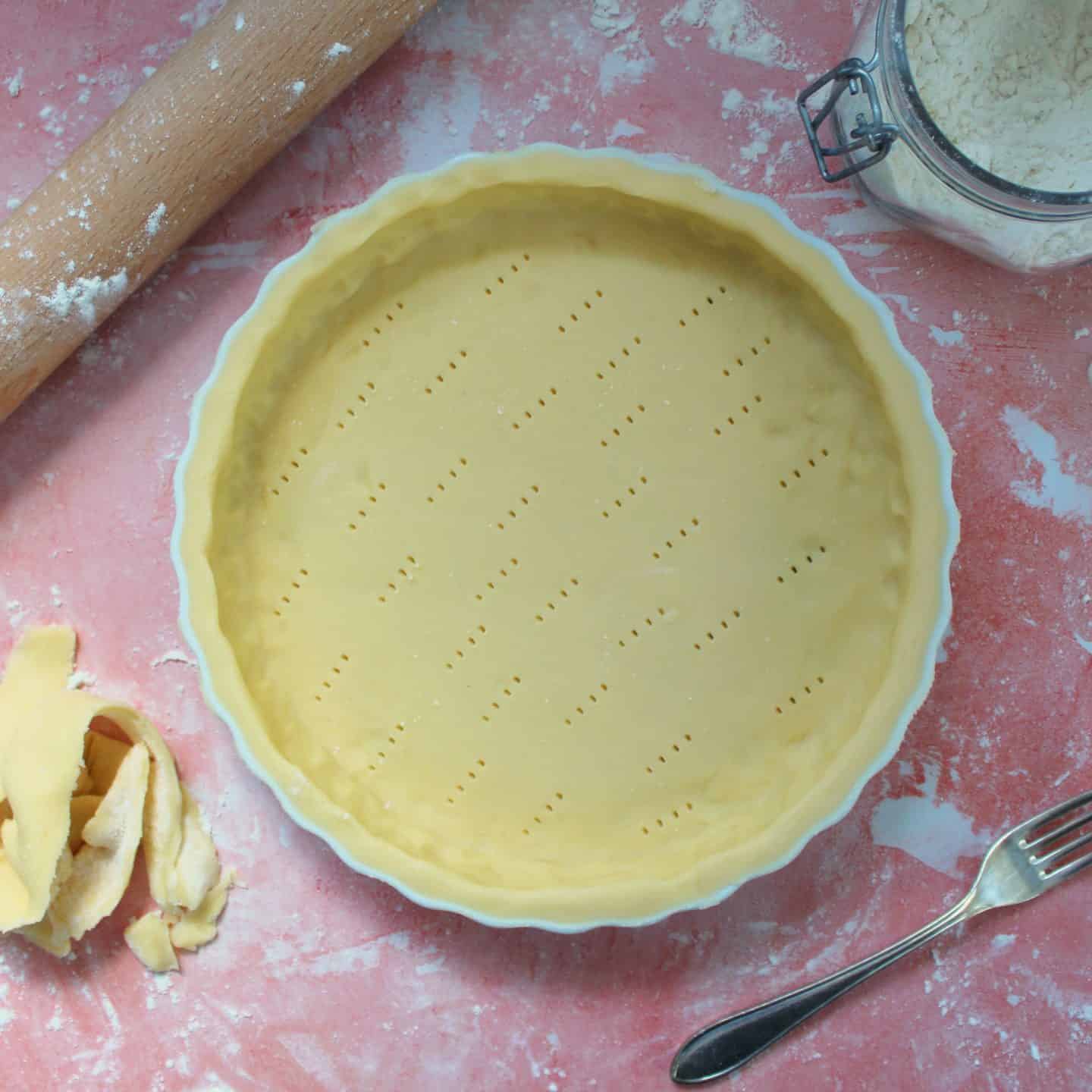
Making gluten free pastry dough
Back in the day, making gluten free pastry used to be an absolute ordeal.
You’d end up with either a sticky mess that couldn’t be rolled, or a pastry so fragile you only had to look at it for it to break into fragments.
But nowadays, making a rich, buttery pastry is SO easy when you’re gluten free.
Here I’ll talk you through an easy step-by-step guide to making gluten free pastry, as well as some variations you can try!
Plus, once you’ve made this, be sure to give my gluten free puff pastry a go too!
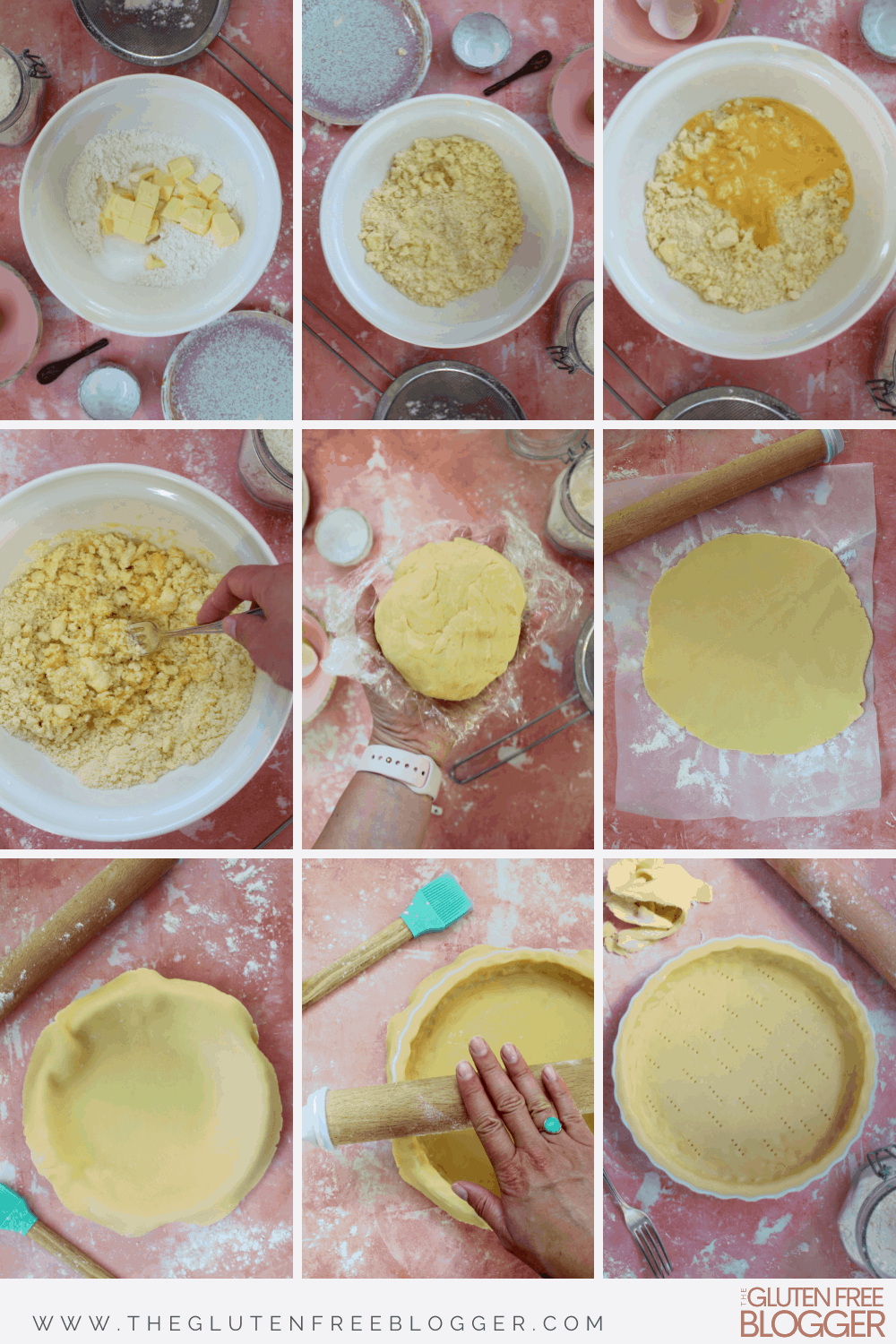
Ingredients
Making gluten free pastry is super simple and you’ll only need a few basic storecupboard ingredients.
The ingredients you’ll need to make my gluten free shortcrust pastry are:
- Plain gluten free flour – I always use FREEE by Doves Farm plain flour. It works every time and it’s available in all supermarkets.
- Xanthan gum
- Medium eggs
- Unsalted butter (or a combination of butter and lard – see below)
- A pinch of salt
What’s the best gluten free flour for pastry?
I always use the plain gluten free flour blend from FREEE which is available in most UK supermarkets.
In the US, you’ll want to use a gluten free All Purpose gluten free flour blend.
Any plain gluten free flour blend should work, as long as it is a blend and not a single flour.
I quite often use supermarket blends of free from flour such as the likes from Asda or Sainsbury’s.
You’ll need to make sure they are a plain gluten free flour though – not self-raising as this will not work in this recipe.
Making pastry from coconut or almond flour, for example, will never work out like it should if used in this recipe.
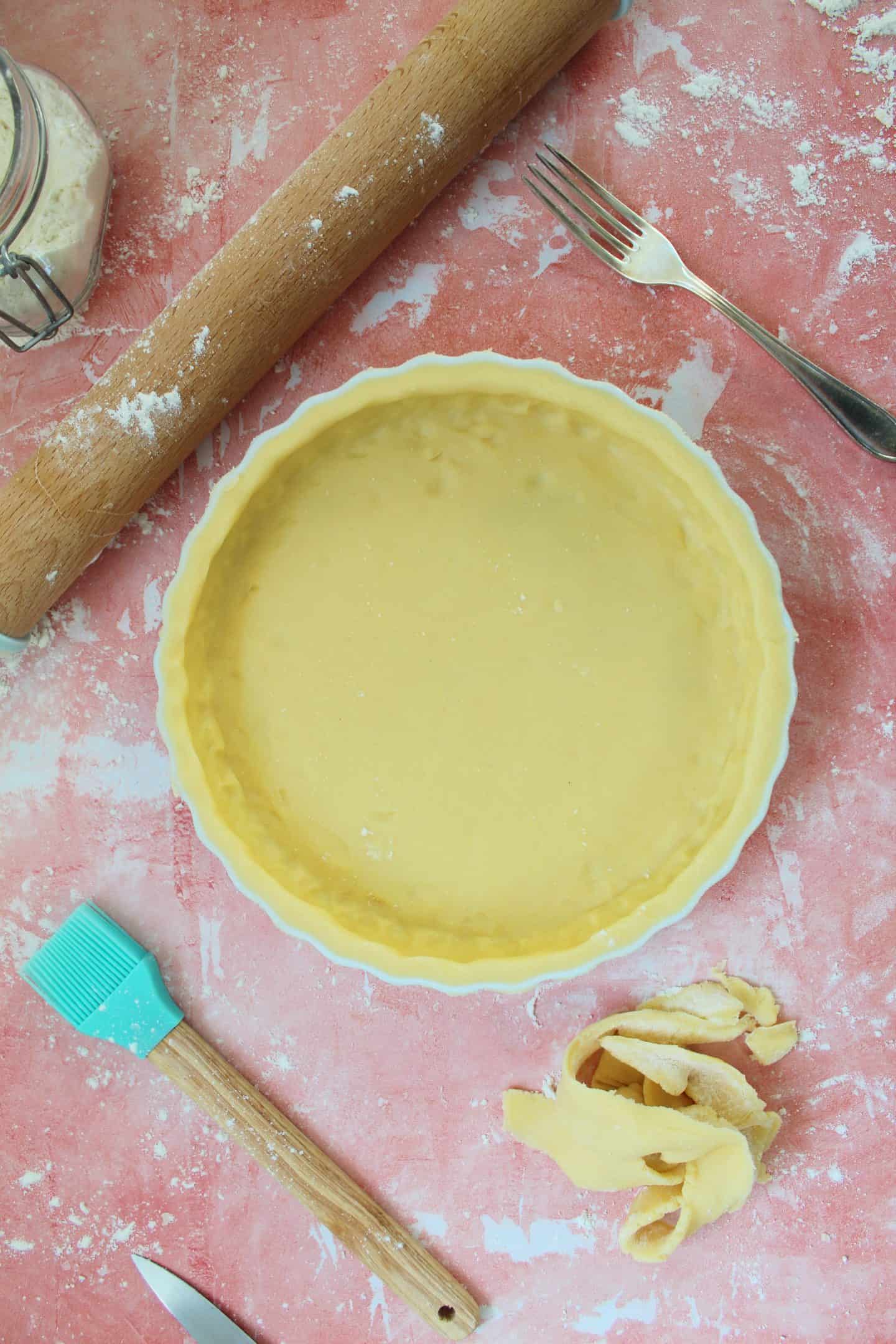
What does xanthan gum do in gluten free baking?
Xanthan gum is really important in this gluten free pastry recipe as it helps create elasticity in the dough.
Typically gluten is what makes dough elastic.
So you’ll often find gluten free recipes can come out a little dry or crumbly.
The xanthan gum helps to replace the elastic texture and will make a much more pliable gluten free dough.
I would not recommend leaving it out of this pastry recipe otherwise you will end up with a sticky mess!
Other ingredients for gluten free pastry
Depending on what you’re making, you’ll also need the following optional ingredients:
- Lard or a vegetable fat such as Cookeen (see below)
- An extra egg for washing (if making something like a pie)
- Milk for washing (if making something like mince pies)
Obviously the amount you’ll need will vary depending on the recipe you’re using, but I always include all the measurements in my individual recipes.
This is more of a general guide to show you exactly how each stage of your gluten free pastry-making should look!
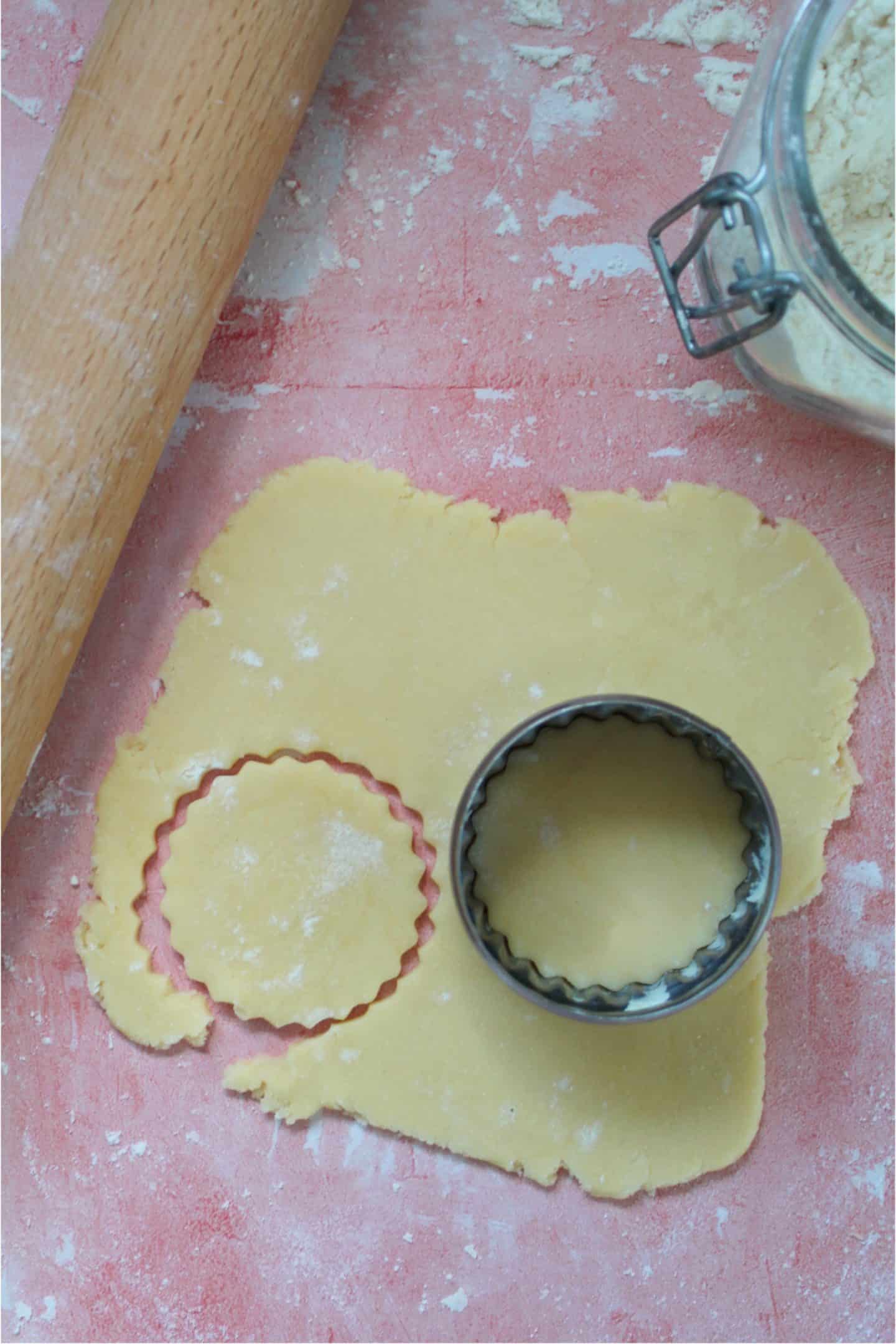
What kind of fat should I use in gluten free pastry?
I tend to go for one of three options when making my gluten free shortcrust pastry.
My favourite combination is to add half lard, half butter.
This creates a deliciously rich pastry which melts in your mouth and works really well with savoury pies.
If you’re vegetarian, you can use half butter and half Cookeen, which is kind of like a veggie version of lard.
This also creates a lovely pastry and works nicely with quiches
But making this pastry simply with just unsalted butter is also delicious.
I like to use this option more for sweet recipes and it results in a lovely, melt-in-the-mouth gluten free pie crust.
I personally have not experimented with dairy free pastry yet, but when I have I will certainly update this guide to reflect that.
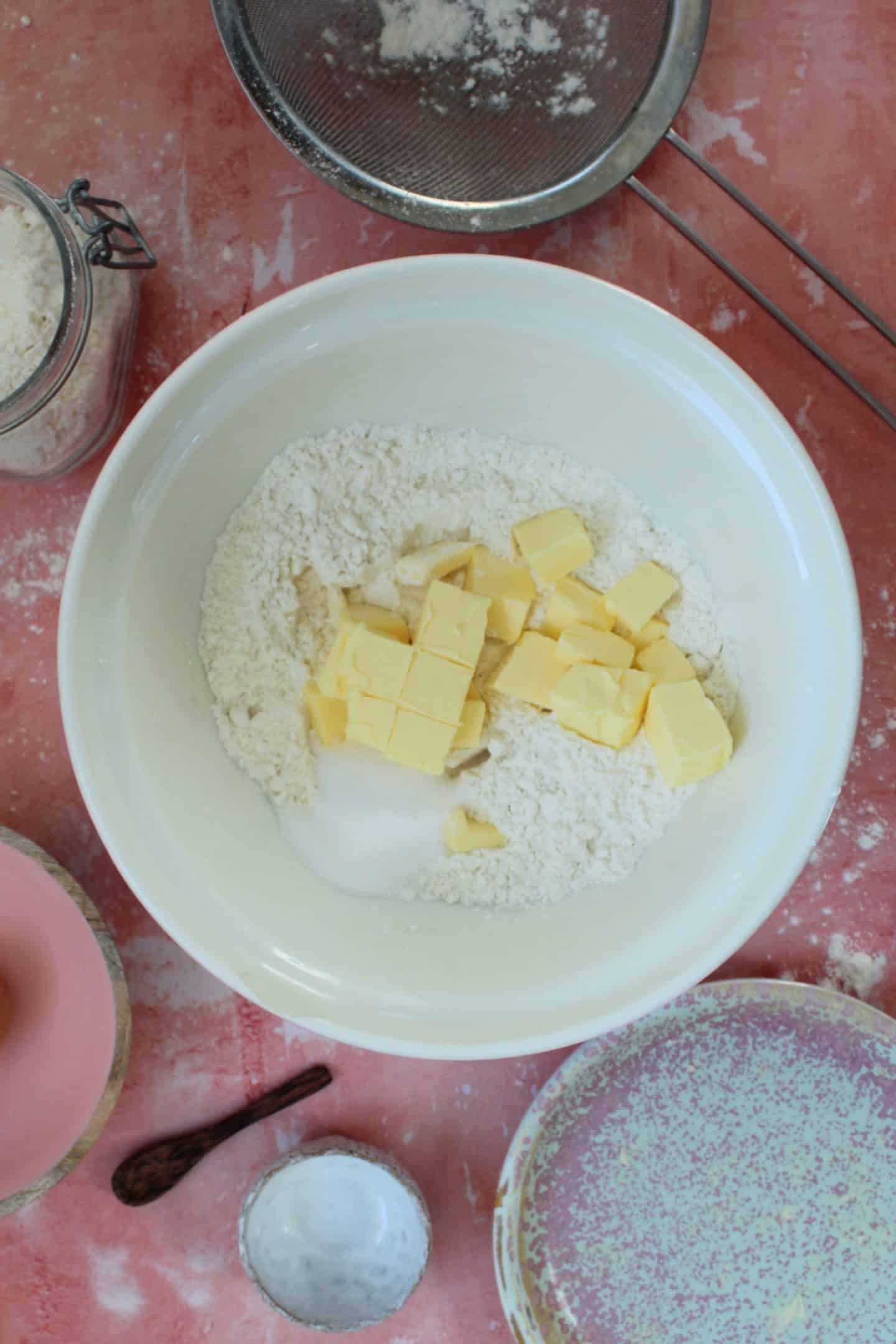
Making sweet pastry
A sweet gluten free pastry is a lovely variation for sweet treats such as Bakewell tart, jam tarts, apple pies, mince pies and much more.
To make your gluten free pastry sweeter, all you need to do is add some caster sugar.
I like to add 1 tbsp to the base recipe above, so adjust this according to how much pastry you’re making.
It just adds a little hint of sweetness and is a great touch for any shortcrust pastry-based dessert.
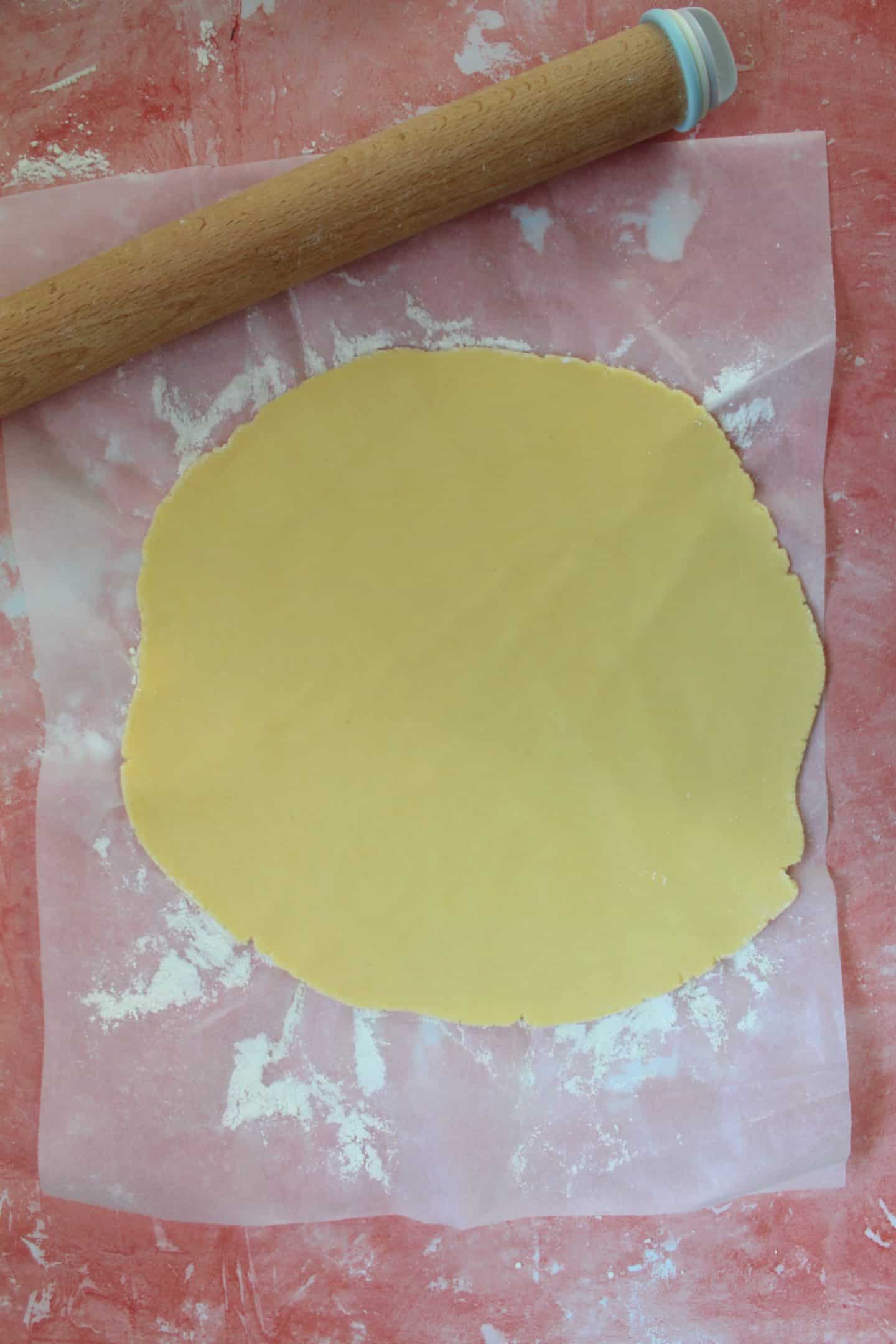
Step-by-step guide to making gluten free pastry
Below is my illustrated step-by-step guide to making gluten free shortcrust pastry.
There’s also a handy video I made too:
This photo guide talks you through exactly how to make my gluten free pastry recipe, and what each stage of the process should look like, as well as some helpful hints and tips.
Below this is a recipe card which you can print out, which has more detailed instructions and cooking times.
Step one: Add the gluten free flour and butter
The first stage in making pastry is to ‘crumb’ together the flour, xanthan gum and butter.
Add the gluten free flour and xanthan gum to a mixing bowl and then add the butter (and Lard/Cookeen if using).
You want the fat to be as cold as possible when you do this, so make sure you take it straight from the fridge.
Then you’ll want to use your fingers to ‘rub’ the two together, until they start to form a breadcrumb-like consistency.
Another top tip here is to make sure your hands are cold – running them under some cold water beforehand helps. Otherwise you’ll find the fat will start to melt and it’ll all become very sticky!
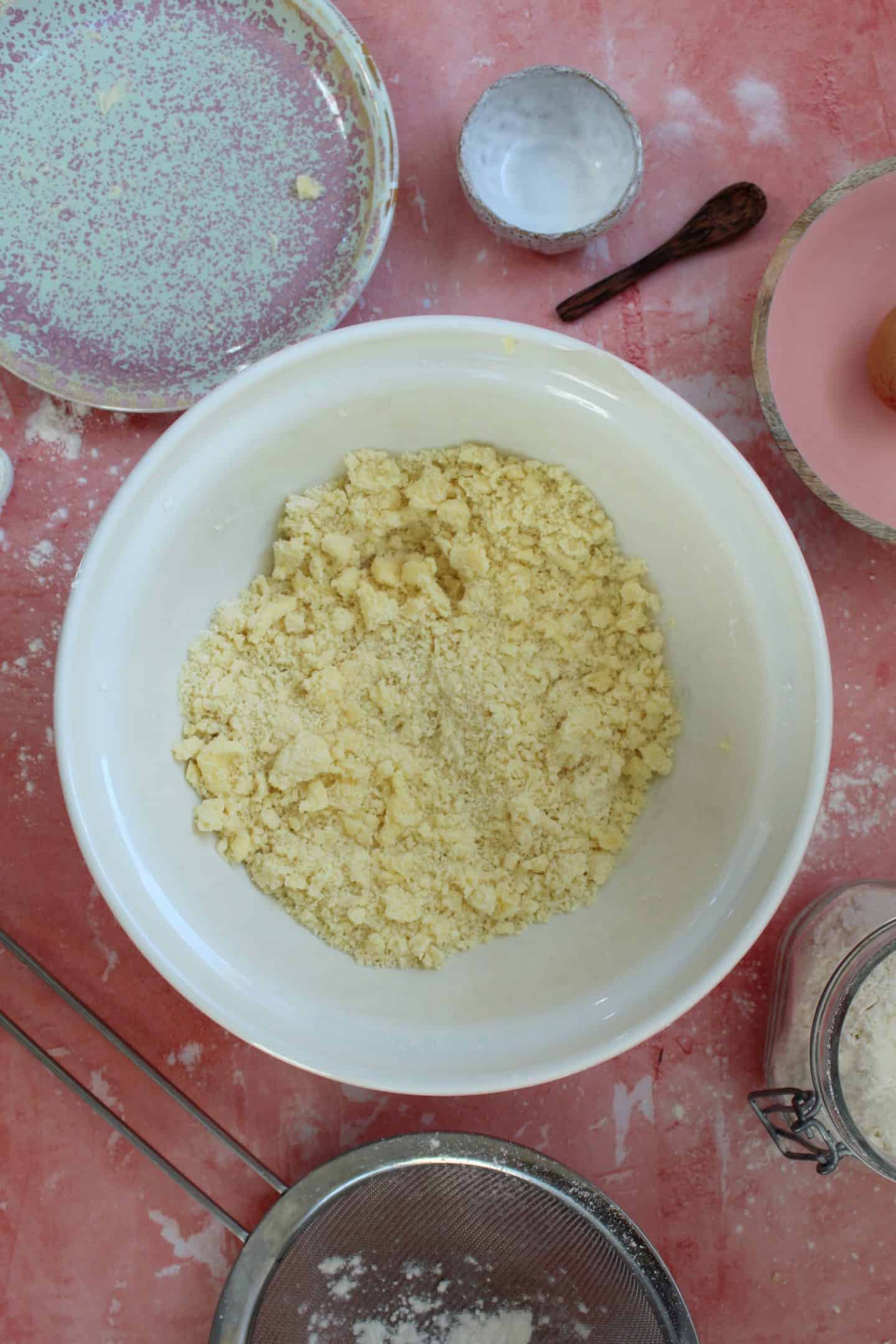
Step two: Add your egg and a little cold water
I like to whisk my egg slightly beforehand with a fork (just to combine it) with 1 tsp cold water per egg used.
Then add to the mix and use a fork to start to ‘mush’ the mixture together. You’ll see it start to form a sticky dough.
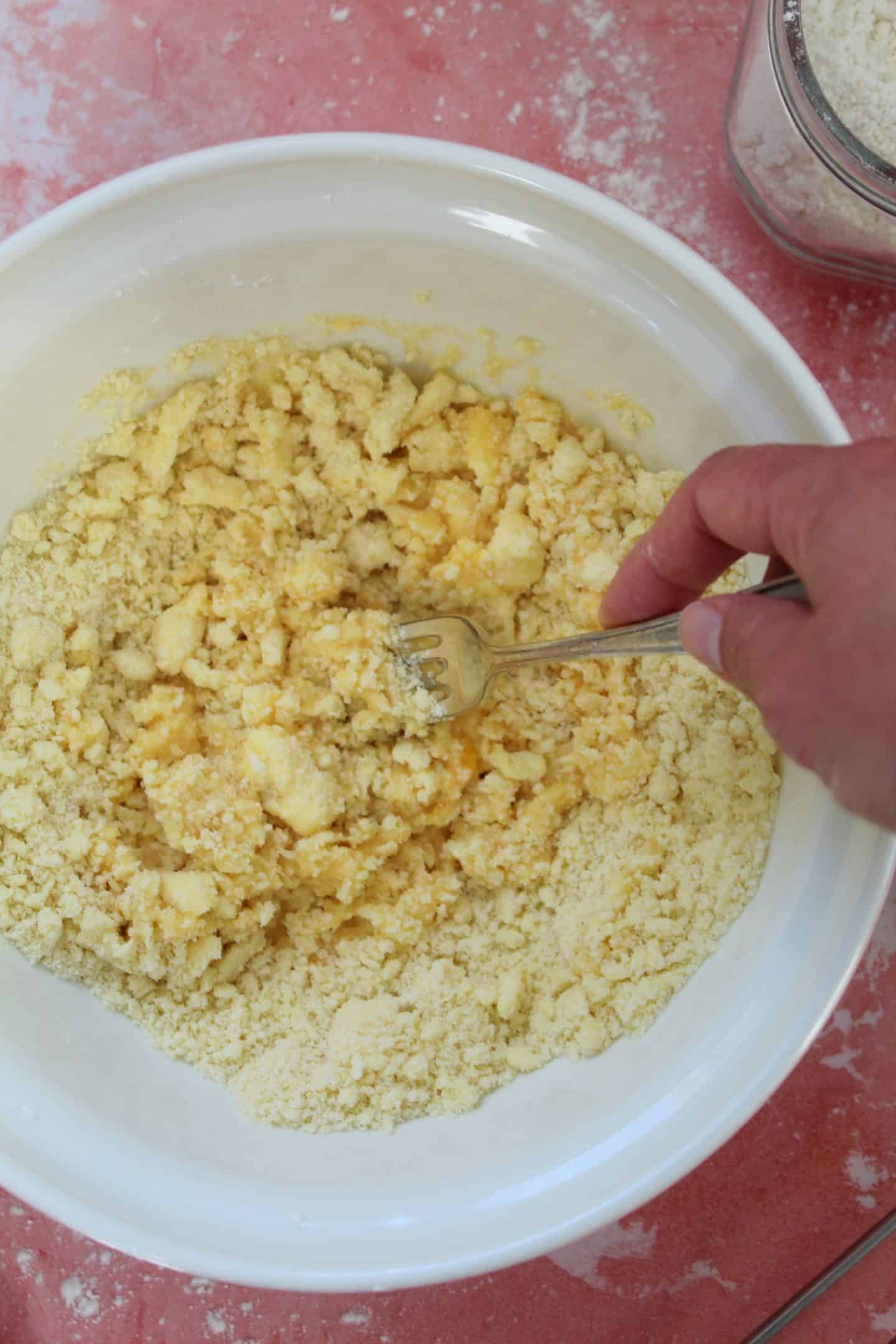
Step two: bring into a dough and chill
Once it becomes harder to use the fork to mix, use your hands to bring the mixture together into a smooth dough.
You should be able to pick this up easily without it being too sticky.
Wrap the dough in clingfilm and chill in the fridge for at least 30 minutes. This is a really important stage – you need the dough to chill a bit so it is easier to roll!
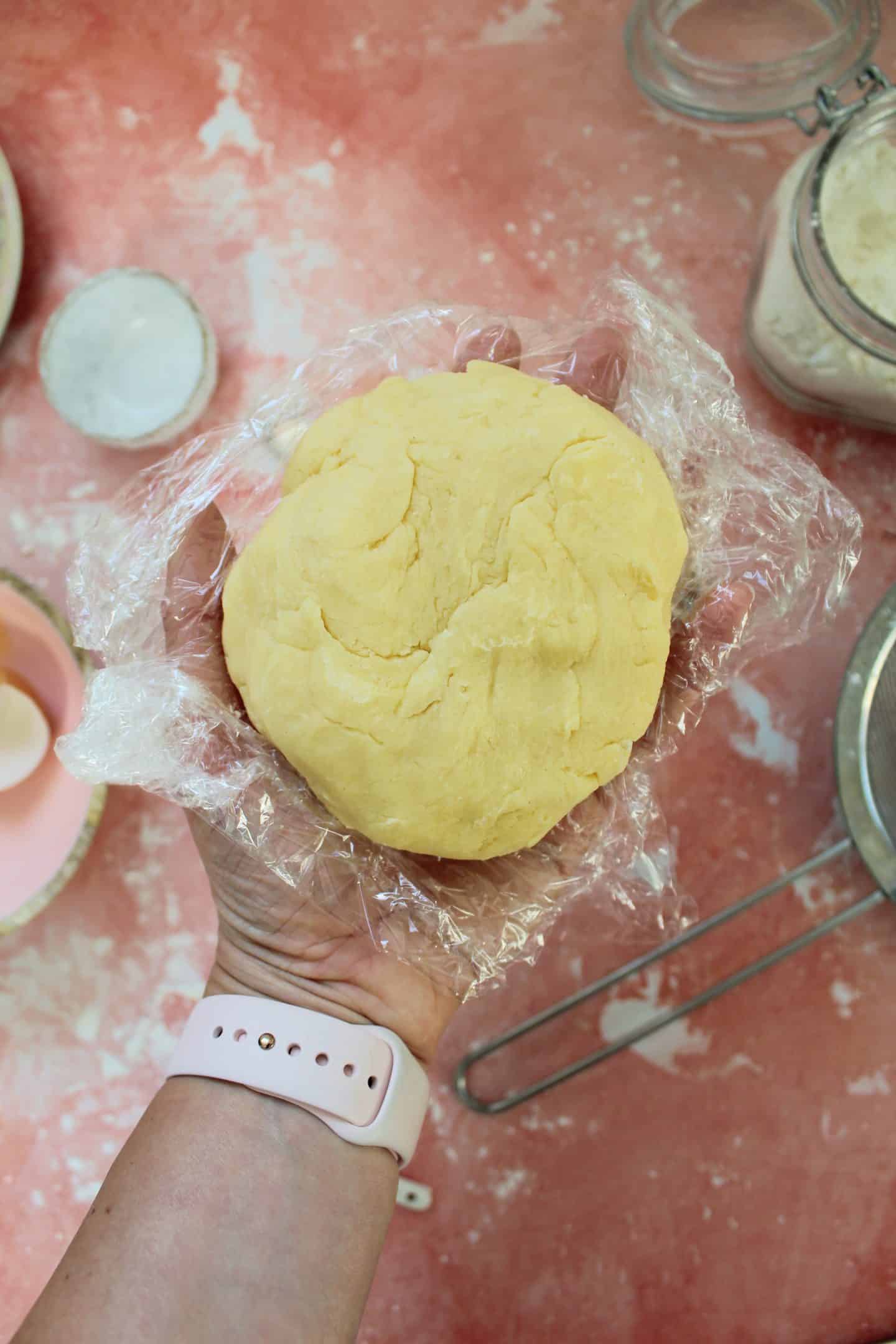
Step four: Get out the clingfilm!
If you’re making something like jam tarts or anything where you’re cutting out small shapes, you should just be able to flour the worktop and rolling pin, and then roll your pastry straight out.
However, if you’re making something like a larger pie or quiche, you may need a helping hand!
The easiest way to roll out your pastry is cover the worktop in clingfilm (or plastic wrap in the US).
Flour the clingfilm/ plastic wrap, place your pastry on top, and then cover with more clingfilm.
This will stop the pastry sticking to your rolling pin as you roll, but will also help you manoeuvre it into a pie dish without it breaking!
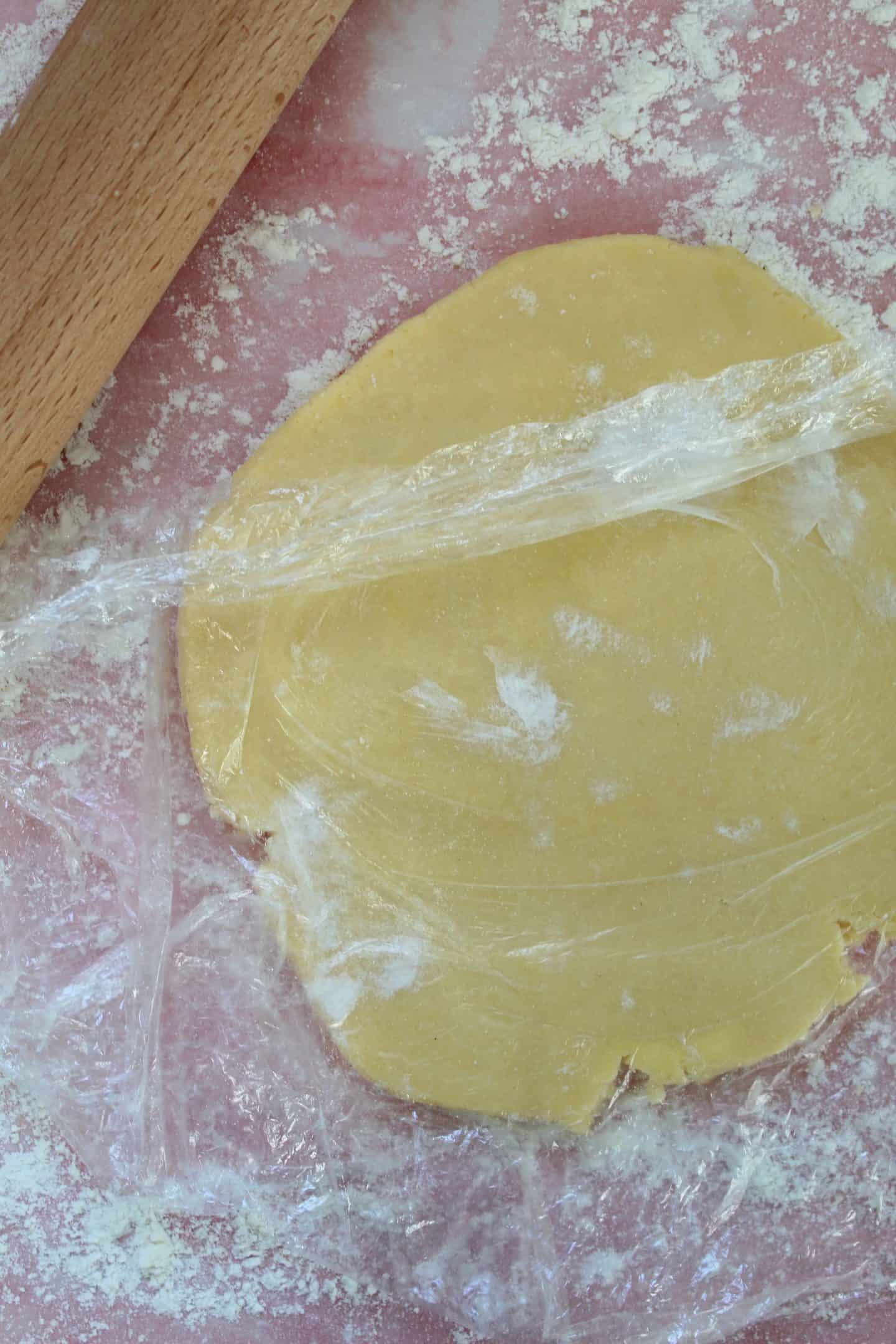
Step five: Moving your gluten free pastry
Once your pastry is rolled out, take off the top layer of clingfilm.
Use the bottom layer to pick your pastry up and flip it into the pie dish.
Then peel off that layer and your pastry is in place!
This also works with baking paper if you don’t have clingfilm, and just makes it easier to move the pastry without it breaking.
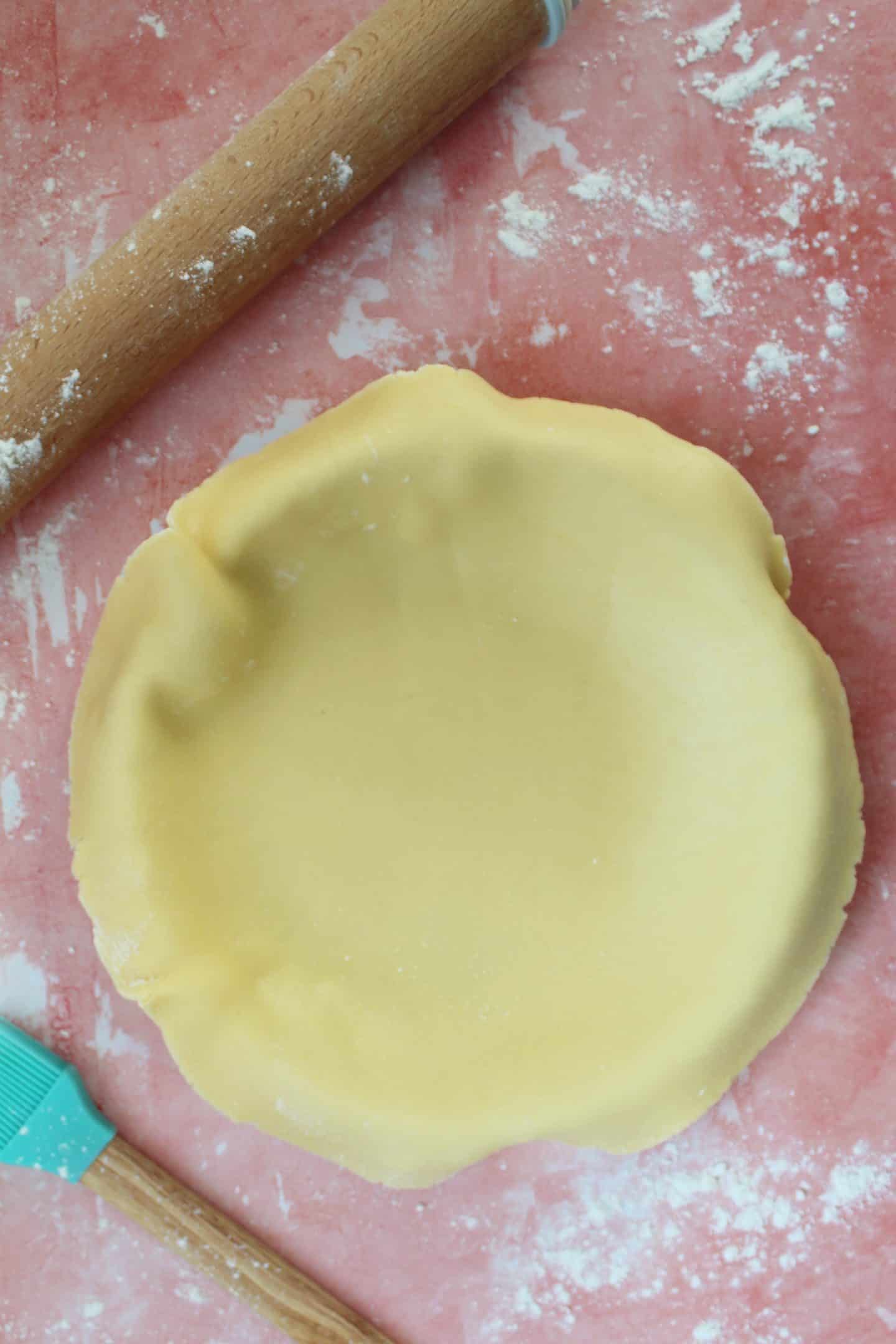
Step six: The perfect fit
To get your gluten free pastry to perfectly fit the dish, the easiest thing to do is break off a bit of the overhang and roll it into a ball.
Use this ball of dough to gently push the pastry into the dish – this will stop you accidentally putting your finger through it!
Once in place, trim the edges – you can use any of the offcuts to patch up your pastry, or re-roll them to create a pie lid.
Although, as a kid, we always used these to make jam tarts!
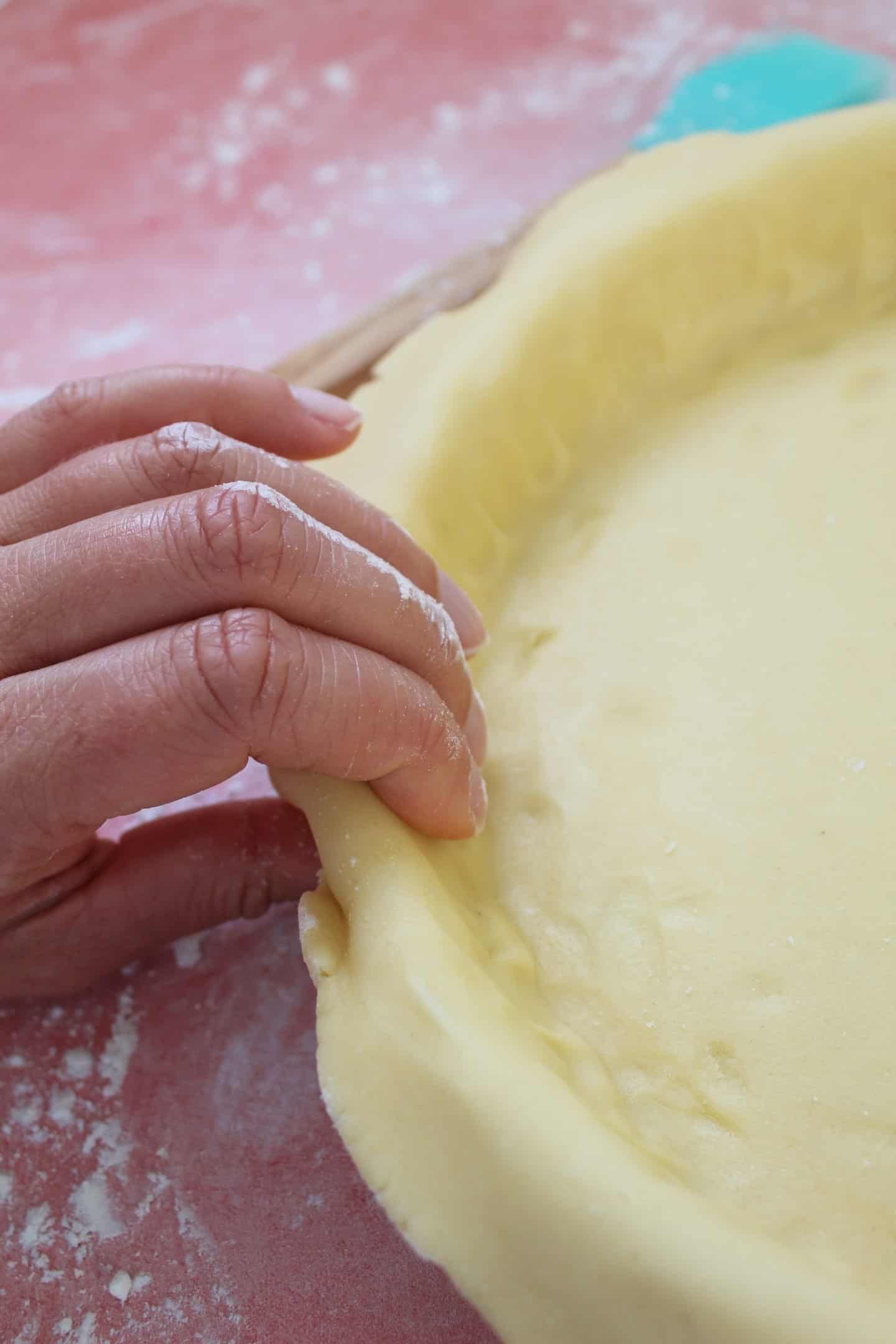
Optional: The blind bake
Some recipes will call for a ‘blind bake’ of your pastry.
To do this, you’ll want to prick the bottom of the pastry to ensure it doesn’t ‘pop up’ due to an air bubble while it cooks.
Place a piece of baking paper over the pastry and then fill with baking beans (or dried lentils/beans).
Bake for the time instructed on the recipe – this usually involves removing the beans half way through so you get a golden look to the pastry.
This isn’t essential in all bakes but it is often used in gluten free pie recipes to ensure you don’t get a soggy bottom!
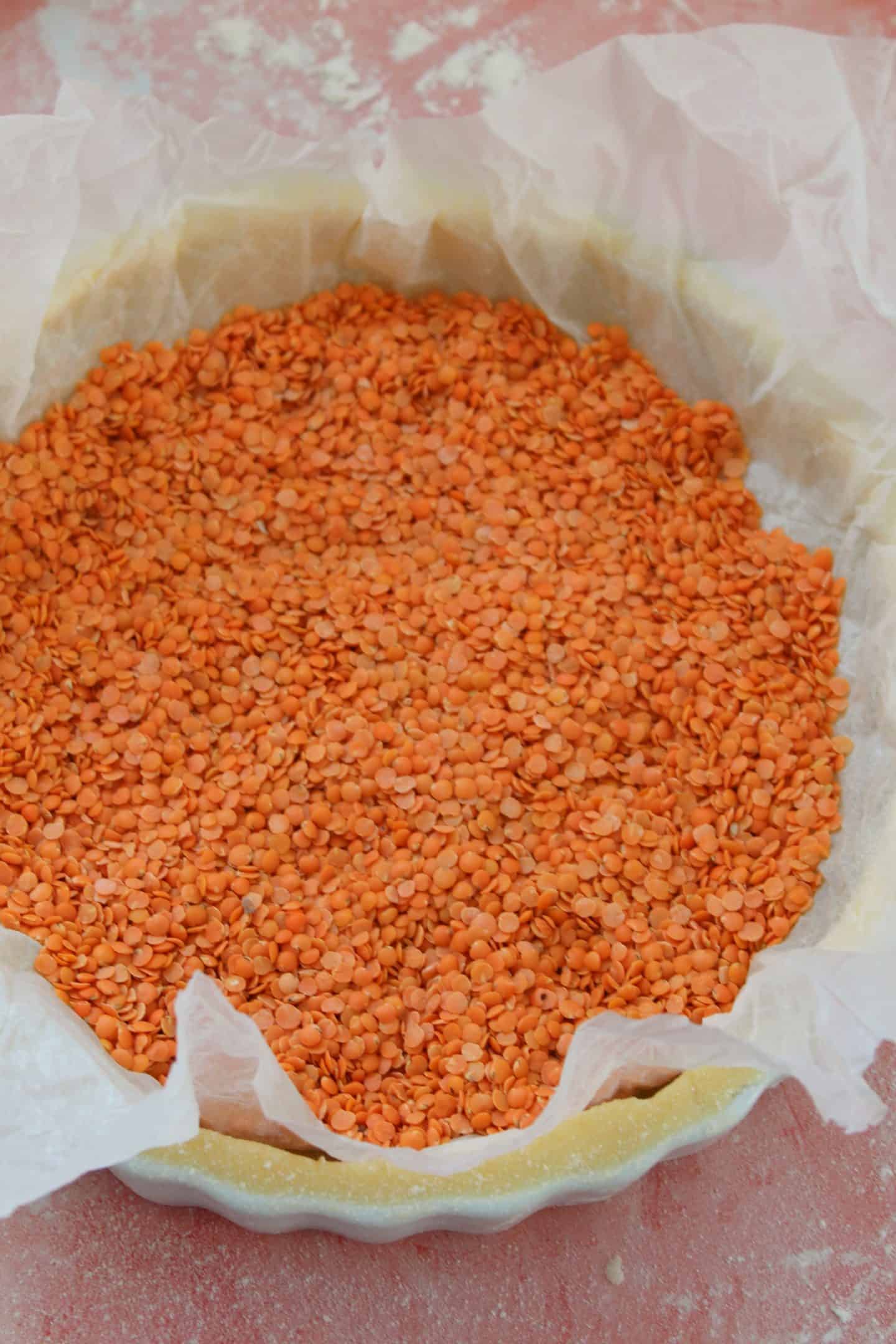
Final step: Fill it up!
Whether you’ve blind-baked your pastry or not, you’ll finally need to fill your recipe.
This will be down to the individual recipe itself, but once filled you’ll need a final bake to ensure your pastry is golden and delicious.
For pies and bakes with a topping, either an egg-wash or brushing with milk is sometimes called for in the recipe for that extra shine or golden touch.
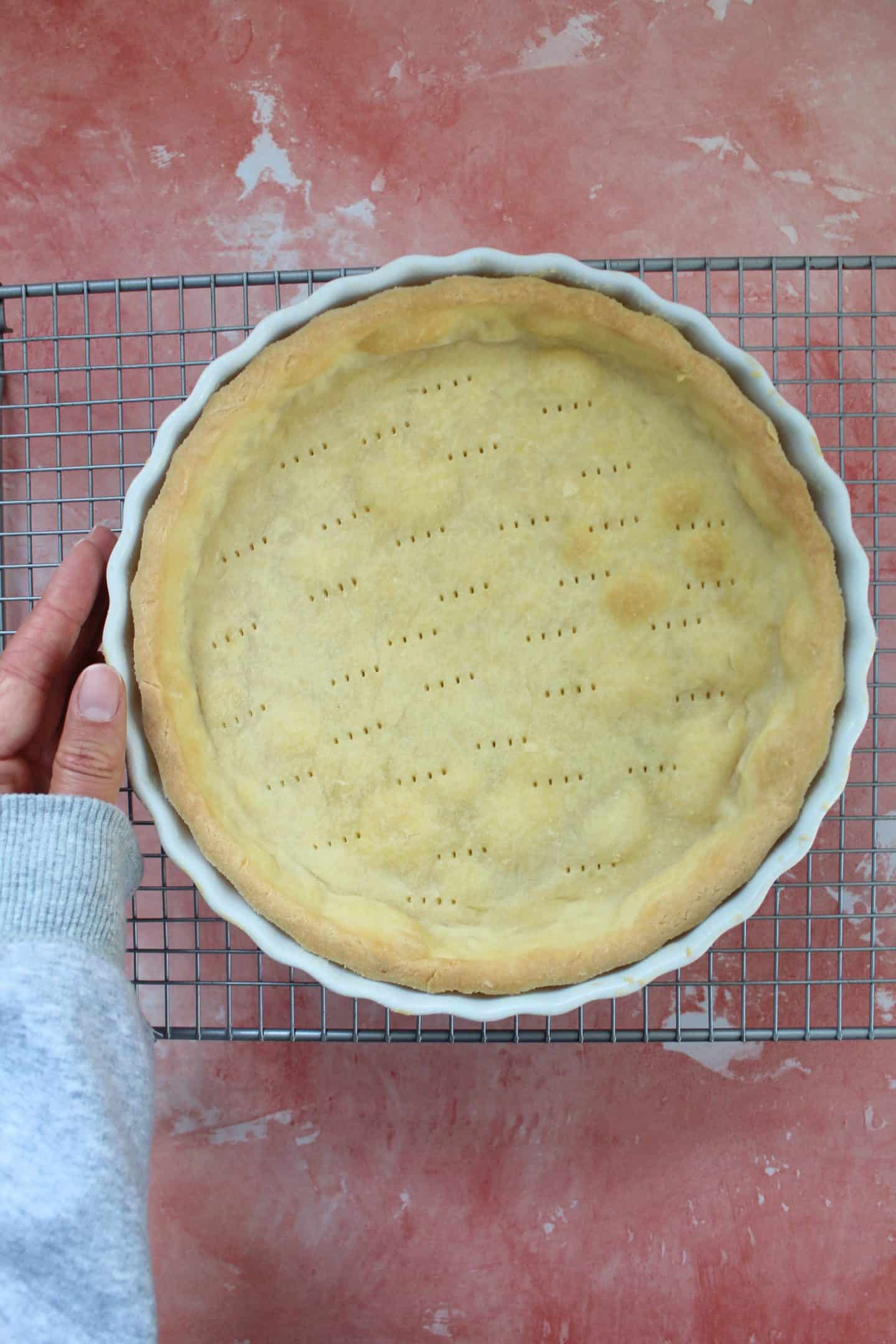
Pastry making FAQs
I know I’ve pretty much covered everything, but in case you have any more questions, here are a few answers for you ready!
Why is my gluten free pastry crumbly?
If you are finding it hard to shape and roll your pastry because it’s crumbly, you may just need a bit more water.
When you re-roll the pastry on a floured work surface, it can dry out a lot.
Just add a few drops of water to the dough (a little goes a long way!) and knead it in.
You’ll find this should rehydrate the gluten free pastry dough and make it less crumbly.
Can I freeze this gluten free pastry?
Yes – freezing this gluten free pastry is really easy!
Simply wrap it tightly in clingfilm, or place in a freezer bag, and freeze for up to 6 months.
Make sure you defrost the dough thoroughly in the fridge before using.
You can also keep this dough in the fridge for several days but you may need to work it out a bit before it’s roll-able.
Can you just buy ready made gluten free pastry?
You can sometimes buy ready made gluten free pastry frozen in UK supermarkets.
But trust me, making it is way more fun! You’ll save money and it’s really not that hard, I promise.
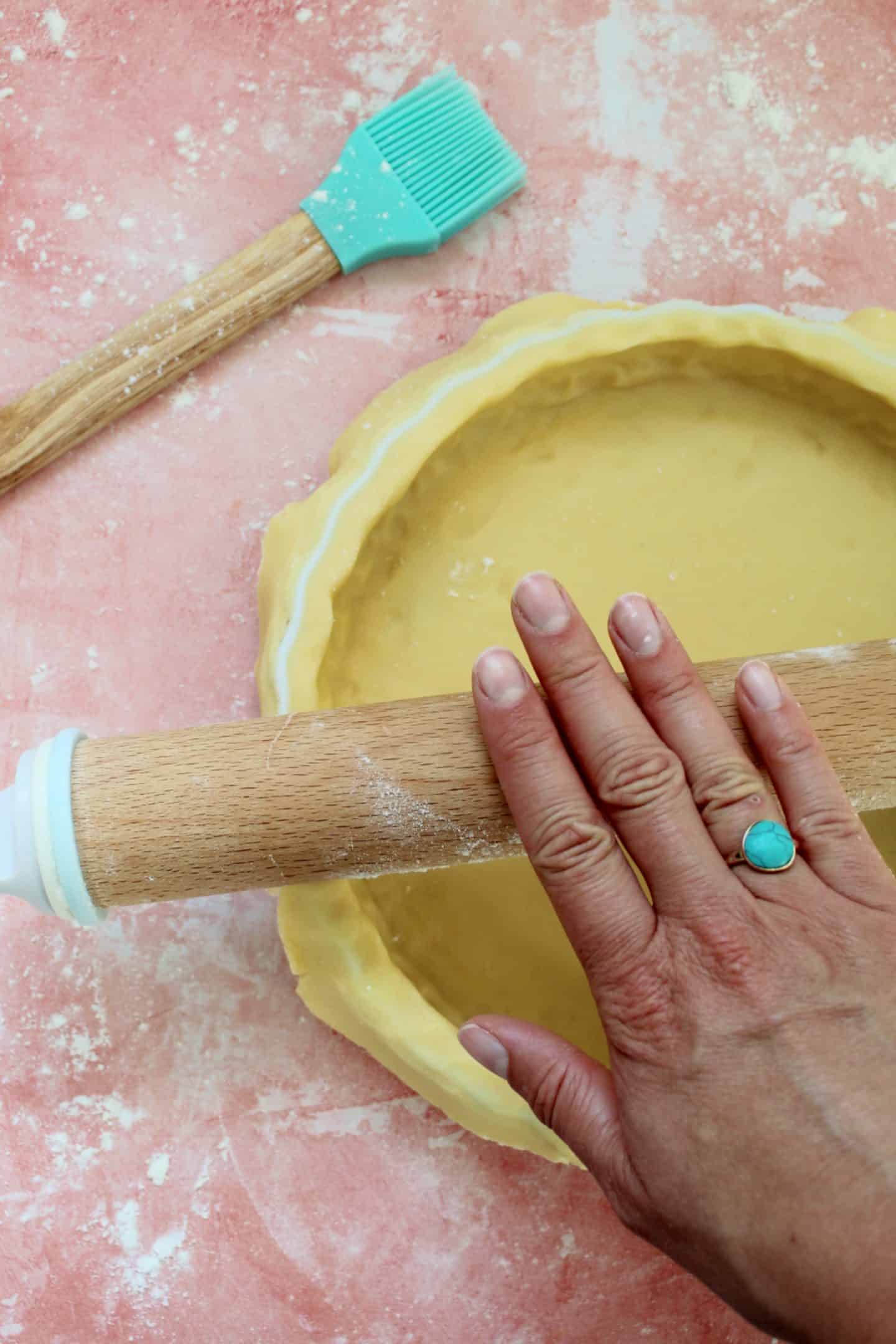
My gluten free pastry recipe
So now you’ve seen my step-by-step instructions, here’s my basic gluten free shortcrust pastry recipe for you!
It’s super simple and easy to follow and I just know you’ll make the best pies, pastries, pasties and tarts – let me know if you give it a try.
If you make this recipe and love it, please do let me know by tagging me on my Instagram or using #theglutenfreeblogger. I love seeing your bakes!
And please do leave a review to let others know you loved it too! It would mean the world to me.
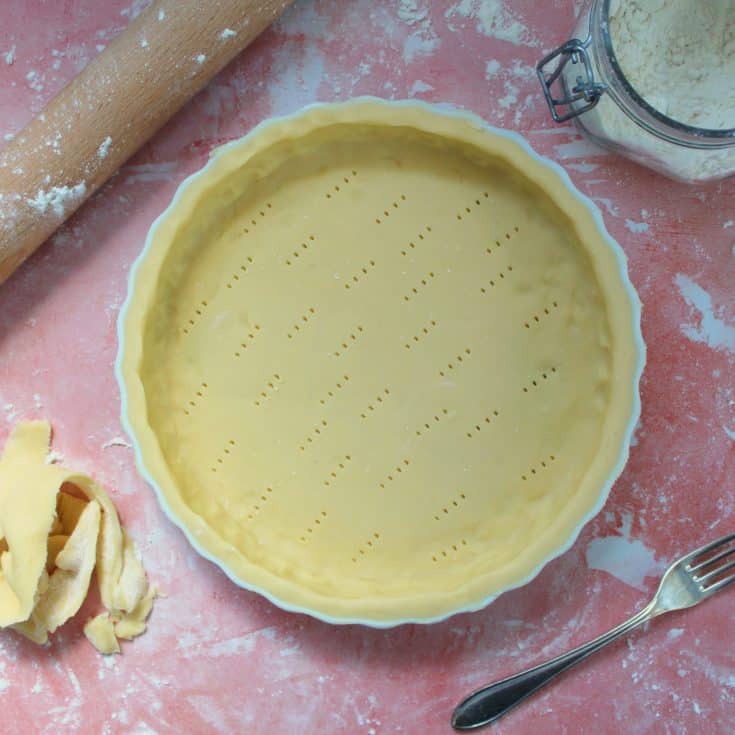
Gluten Free Pastry
This easy gluten free pastry recipe makes enough for one 20cm diameter pie or approximately 12 lidded mince pies. For a quiche I would recommend cutting the quantities in half. The pastry dough can also be frozen, defrosted and then rolled out as needed.
Ingredients
- 340 g plain gluten free flour
- 2 tsp xanthan gum
- 2 medium eggs
- 2 tsp water
- 220g unsalted butter (cold)
- Pinch salt
Optional:
- 1 tbsp caster sugar
- 1 egg (beaten)
Instructions
- Add the flour, xanthan gum, salt (and sugar if using) to a large mixing bowl and stir together.
- Cut the COLD butter (and Cookeen/lard if using) into cubes and then add to the bowl. Using your fingers, rub the mix together until it resembles breadcrumbs.
- Crack the eggs into a bowl or mug and add the cold water. Whisk together until just combined. Then add to the mix and use a fork to start to ‘mush’ the mixture together. You’ll see it start to form a sticky dough.
- Once it becomes harder to use the fork to mix, use your hands to bring the mixture together into a smooth dough. You should be able to pick this up easily without it being too sticky.
- Wrap the dough in clingfilm and chill in the fridge for at least 30 minutes. This is a really important stage – you need the dough to chill a bit so it is easier to roll!
- Roll the chilled dough between clingfilm to your desired thickness. I usually roll it to between 4-6mm for pies, tarts and quiches.
- Either cut the mini shapes using a pastry cutter, or transfer to a pie dish if making a quiche/pie before blind baking and/or filling.
- If you need a 'blind bake' in your pastry recipe, carefully use the rolling pin to lift the pastry into your pie dish. Don't worry about trimming any overhang yet.
- Use your fingers to press the sides of the pie into the ridges of the dish. Break off a small piece of the overhanging dough and roll into a ball - use this to press the pastry in further (it will stop your finger nails going through the pastry!).
- Gently push the overhanging pastry back over the pie dish so you have a couple of mm which are slightly thicker at the top of the pie crust. This will help to minimise any shrinking. Roll the rolling pin over the top of the dish and then remove any excess pastry and prick the bottom all over with a fork.
- Place a piece of baking paper over the top of the pastry and fill with baking beans (or dried rice/lentils).
- Bake in a preheated oven at 180'C / Fan 160'C / Gas Mark 4 for 10 minutes. Carefully remove the baking paper and beans, then bake for another 5-10 minutes until golden.
- Fill and bake the pastry case as per the individual recipe you're following - I have a few suggestions below this recipe card!
- For mini pies, roll the pastry to the desired thickness and use a pastry cutter to cut out the shapes you need. Re-roll any excess and repeat until all the pastry is used up. If it gets a little dry and crumbly, wet your hands slightly and work the pastry so it moistens a little. If it gets too sticky, chill it for 10-15 minutes before rolling.
- For a golden pie top, brush the pie lid with a beaten egg before cooking. For sweet pies you can then also sprinkle with a little sugar too!
To blind bake:
For pies and mini tarts:
Notes
- It's important to use cold fat in this recipe - if the butter becomes too warm if will affect the pastry's texture.
- I always use the FREEE by Doves Farm plain gluten free flour blend for this but any gluten free plain flour or all purpose flour blend should work.
- You can use a mixture of 110g unsalted butter and 110g Lard/Cookeen if you prefer. Add the lard/Cookeen as you would the butter - cold and cubed.
Recommended Products
As an Amazon Associate and member of other affiliate programs, I earn from qualifying purchases.
Nutrition Information:
Yield:
12Serving Size:
1Amount Per Serving: Calories: 274Total Fat: 18gSaturated Fat: 9gTrans Fat: 0gUnsaturated Fat: 8gCholesterol: 71mgSodium: 29mgCarbohydrates: 23gFiber: 1gSugar: 1gProtein: 4g
Want to put your gluten free pastry to use?
Here’s a selection of some of my recipes on the blog where you can use my gluten free shortcrust pastry:
Savoury gluten free pastry recipes
- Gluten free Cornish pasty
- Steak and ale pies
- Gluten free cheese and onion pasty
- Mexican quiche recipe
- Chicken and Ham Pie
Sweet gluten free pastry recipes
Plus don’t forget to check out my gluten free puff pastry recipe for perfect flaky pastry – sausage rolls and cheese straws galore!
I’ll make sure I keep updating this as I add more recipes to the site, so do bookmark it and keep checking back!
If you do make this recipe please let me know! I’d love to see your photos using #theglutenfreeblogger, share them in my Facebook group or tag me on Instagram.
And if you have any recipe suggestions, please let me know in the comments what you’d like to see next!
Oh – and don’t forget to sign up for my e-newsletter where you’ll know about all my latest posts and competitions first!
Like this gluten free pastry recipe?
Make sure you pin this recipe cards below for later!
Do head over and follow me on Pinterest too for more gluten free recipe inspiration.
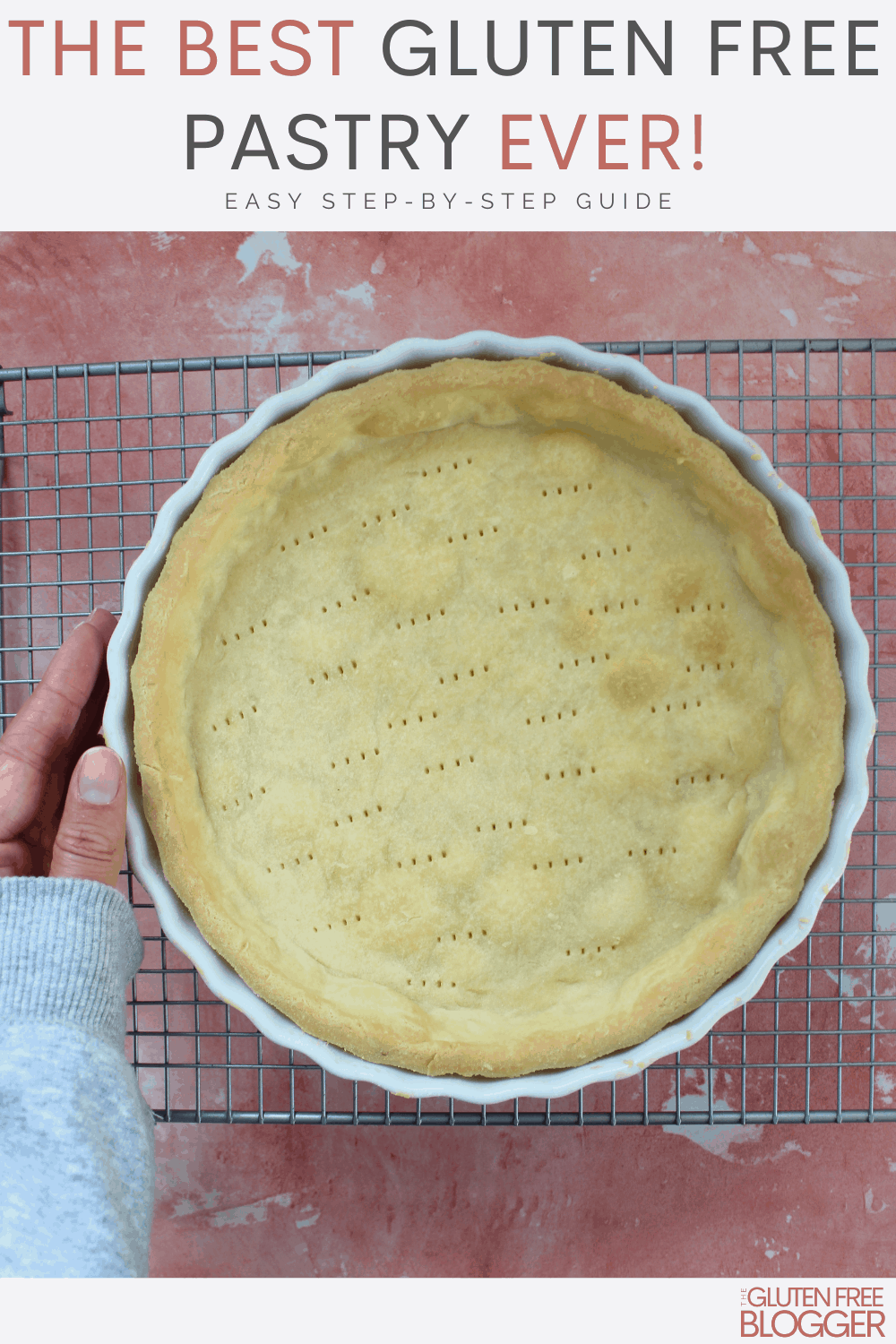
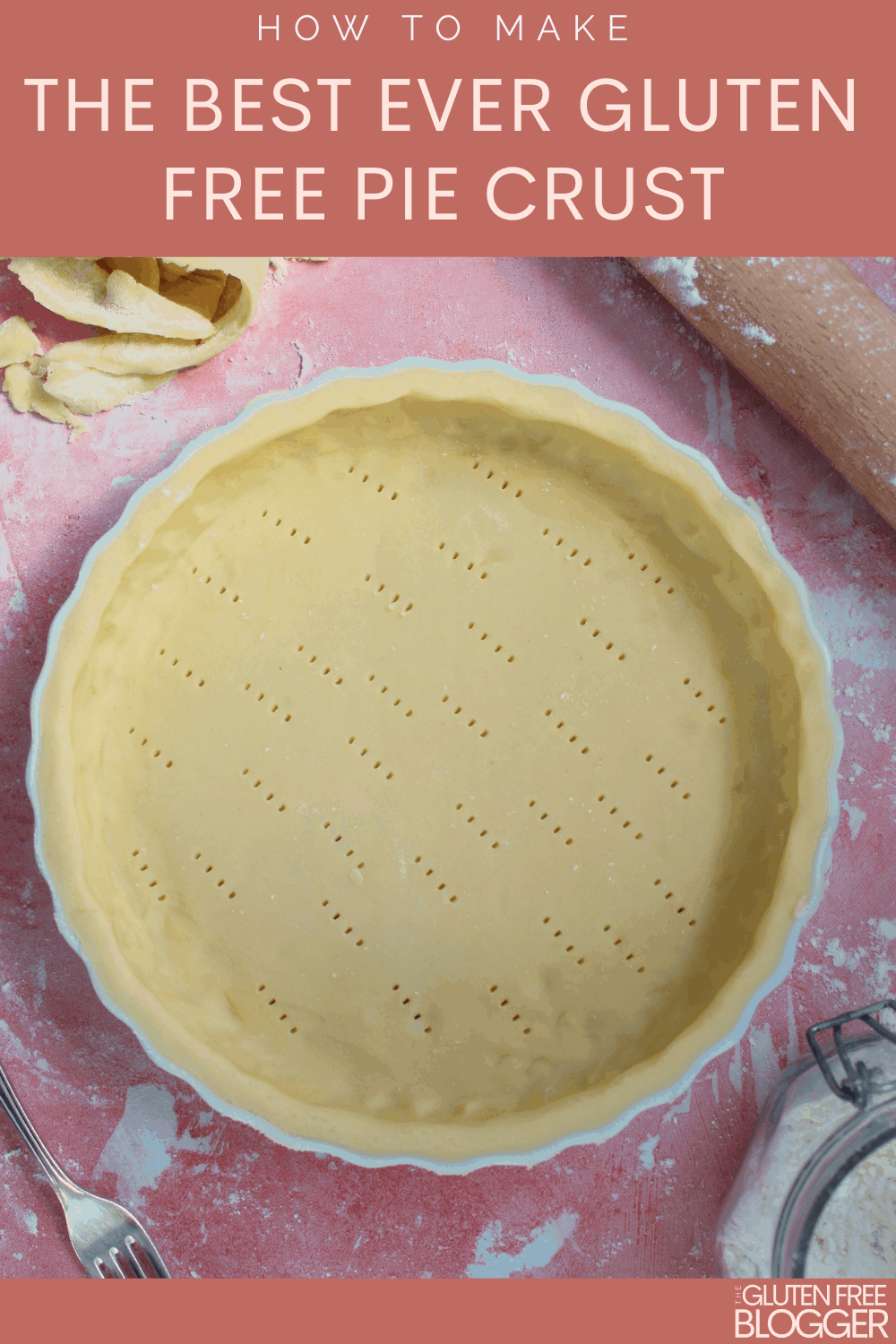

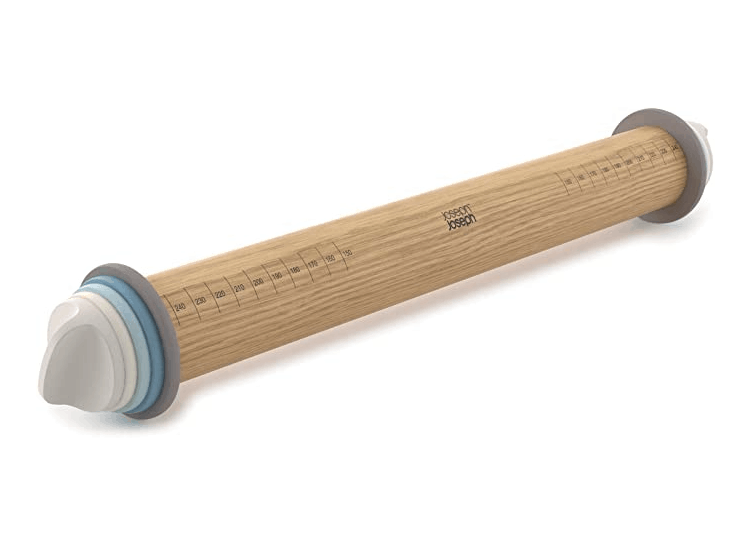
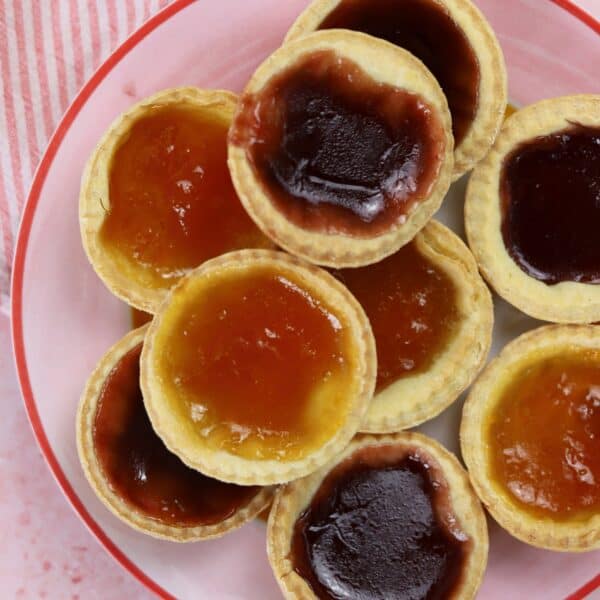
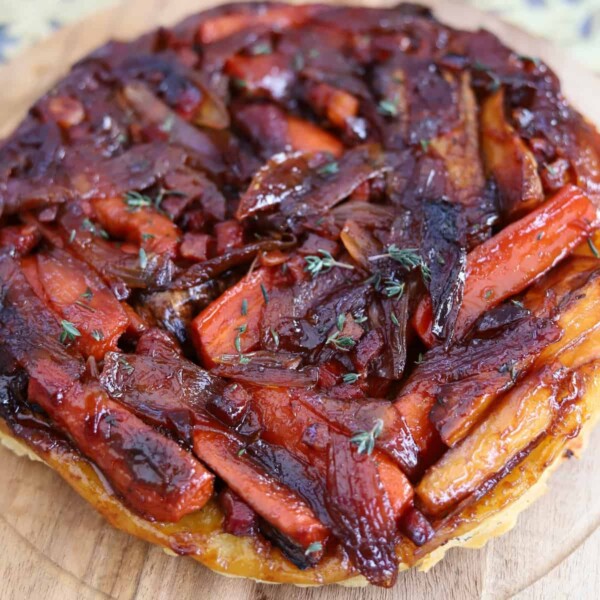
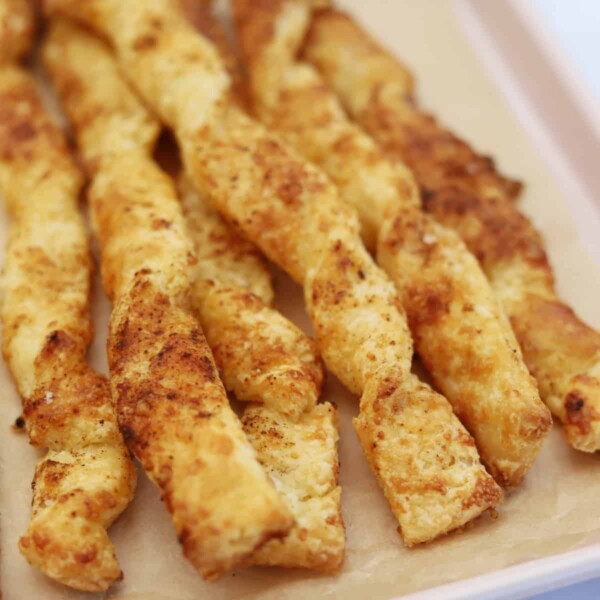
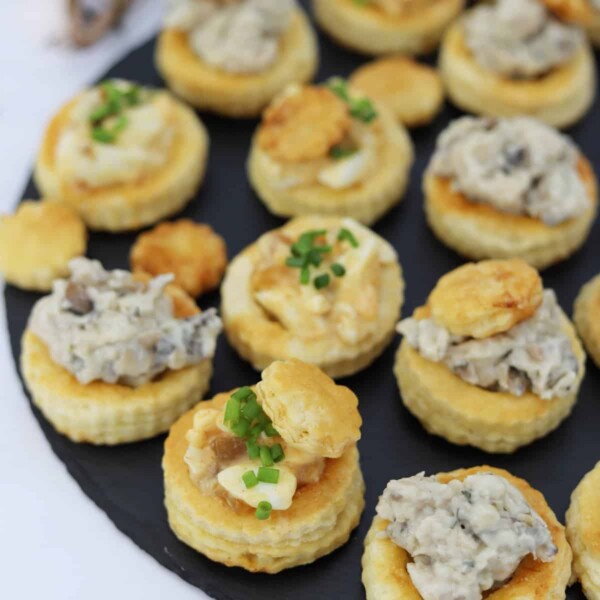









Keep on coming back to this shortcrust recipe when cooking for my Coeliac mother, very good, light texture. Thank you for sharing.
Thank you for this recipe. As I do not live in the UK nor the USA I would like to make my own flour. Would you kindly list the ingredients in the flour? And the quantities too, please.
I had to throw it away as it was so wet and I didn’t have any GF flour to fix it with. I don’t think its the fault of the recioe (and will try it again tomorrow with no water) but I think GF flour & dairy free butter together are just temperamental. Used Dove’s GF flour as it’s all I had on hand (even though I find it super gritty and much prefer Schar GF flour, but Schar’s often harder to find) and Flora plant ‘butter’ block direct from the freezer, and even before adding the egg and water it was a soft dough and I added the water and egg mix and it turned into almost the consistency of whipped icing (it literally audibly squished and felt wet when I added the water and egg mix)
I know extra GF flour probably could have saved it, but I had no more GF flour as I used it all for the dough.
Every pastry type recipe I try with DF butter block (mostly from the freezer) and GF flour just never work. Always goes so oily. Unless I roll it between parchment (which I struggle with as I have motor skills issues, and the parchment keeps coming back up, and also getting it even) and even sometimes if I mamage to to it gets so oily it’ll stick to the surface, and the rolling pin and itself. Even rolling it back up, throwing it in the freezer for 5-10 mins (any longer and jts frozen solid) or in thr fridge for an hour and as soon as I start rolling it, same issue. Even when I cut out the shapes, I can’t pick them up off the parchment as they melt amd collapse. Even things like shortbread dough, same issue. Seems its the GF flour & dairy free butter combo.
I want to try a recipe like yours with xantham gum as apparently (I posted in a Facebook group) it might stop it being so oily when rolled out. ( I cant eat gluten, and to a lesser exent, dairy)
So I am going to try this again tomorrow without water when I can get more GF flour. But do you have any idea why DF butter and GF flour do this and how to deal with it? I’ve even tried switching vegan butter block brand but jt didn’t help.
Just made this and so happy with the results! Has to be the best pastry I’ve ever made even pre coeliac days! Thanks so much for this one and all the others over the past year your Facebook page and group have rescued me from despair when diagnosed 😁
How many eggs do you actually use? Your video only shows you using 1, but your recipe calls for 2.
2 eggs as per the recipe
I tried this crust last year, and cannot have egg, so used a Chia Egg replacement. I don’t actually know how it feels with an egg because I haven’t done that at all, but the Chia egg turns out ok.
Glad to hear it worked well with the chia egg replacer!